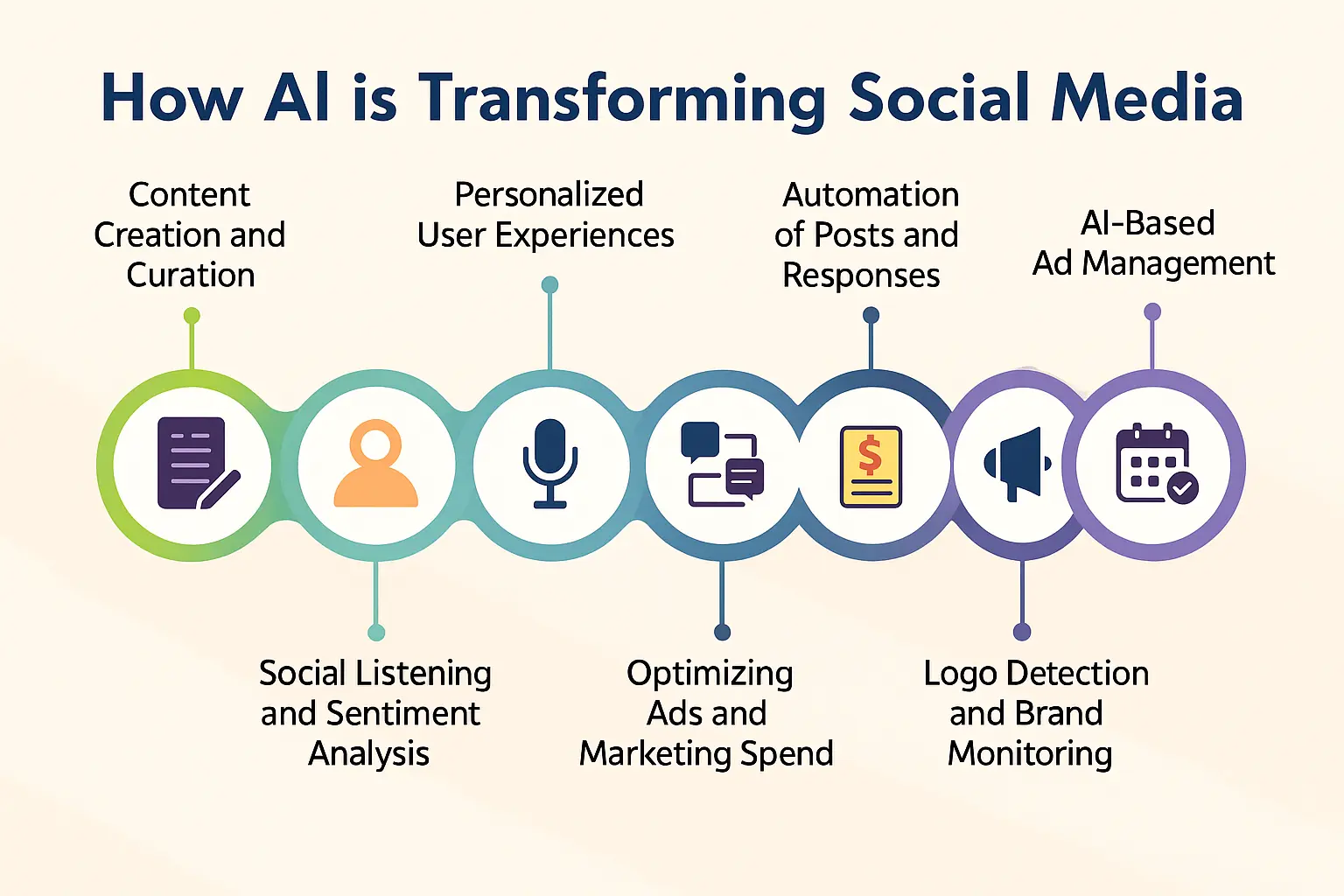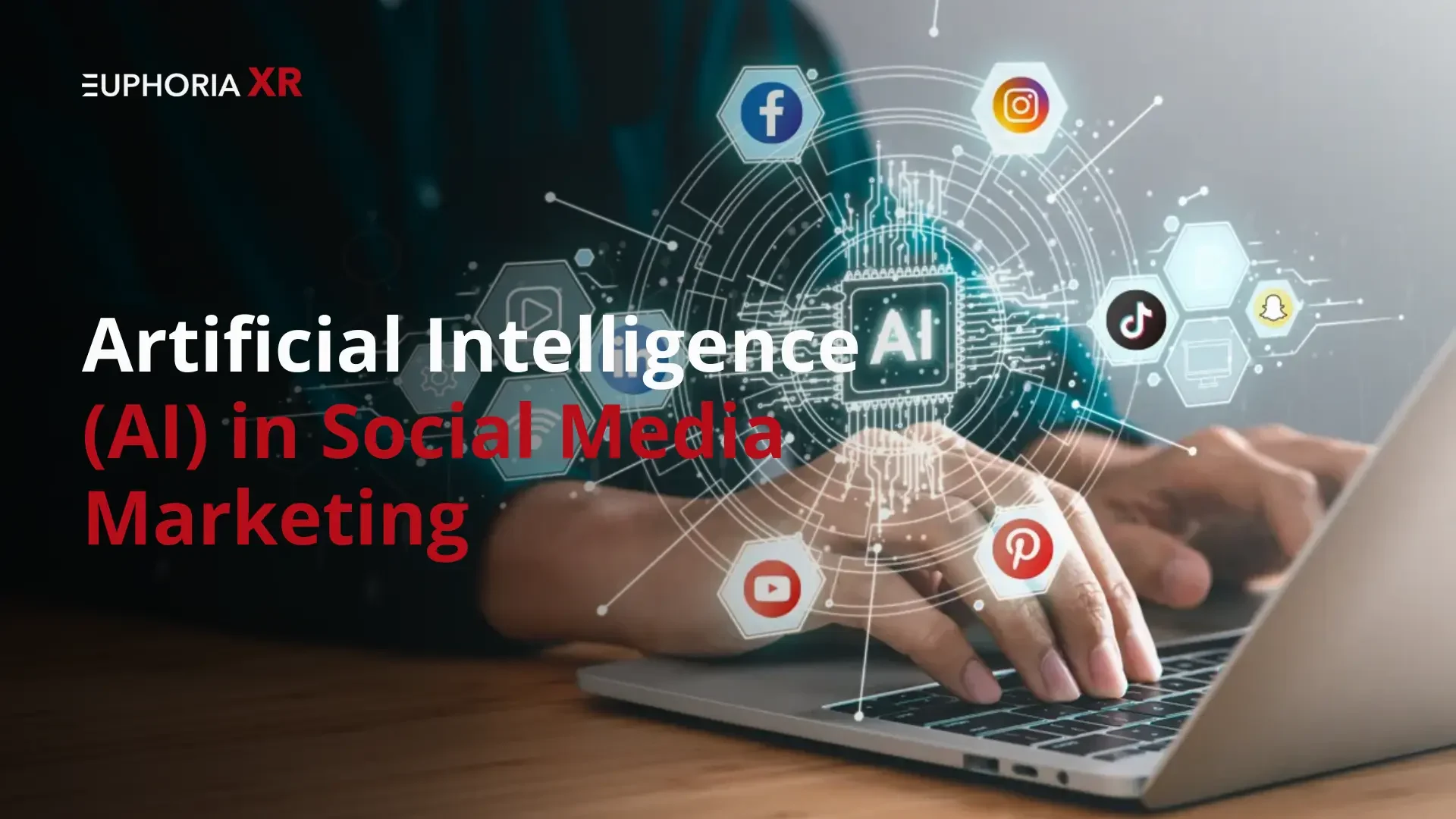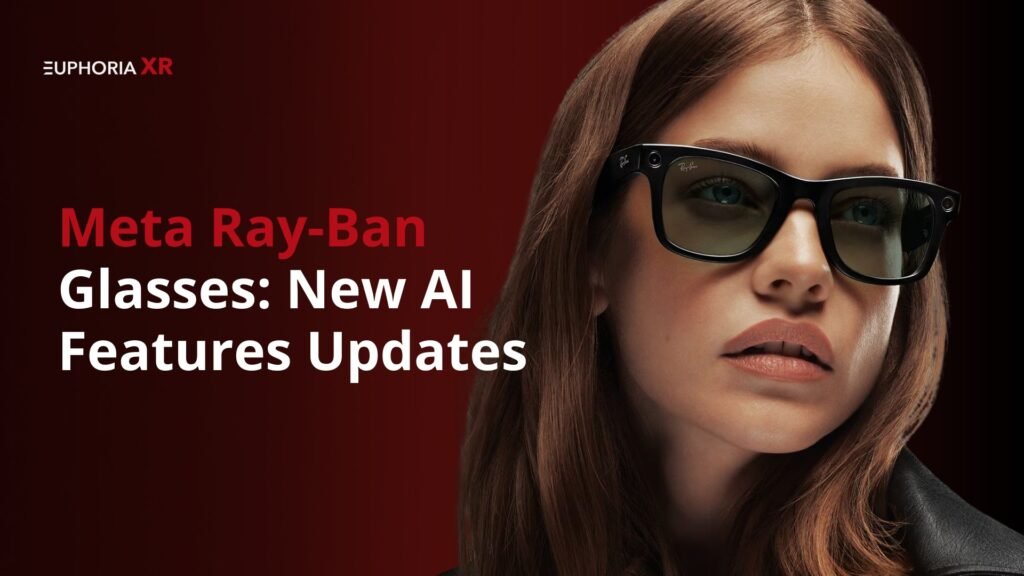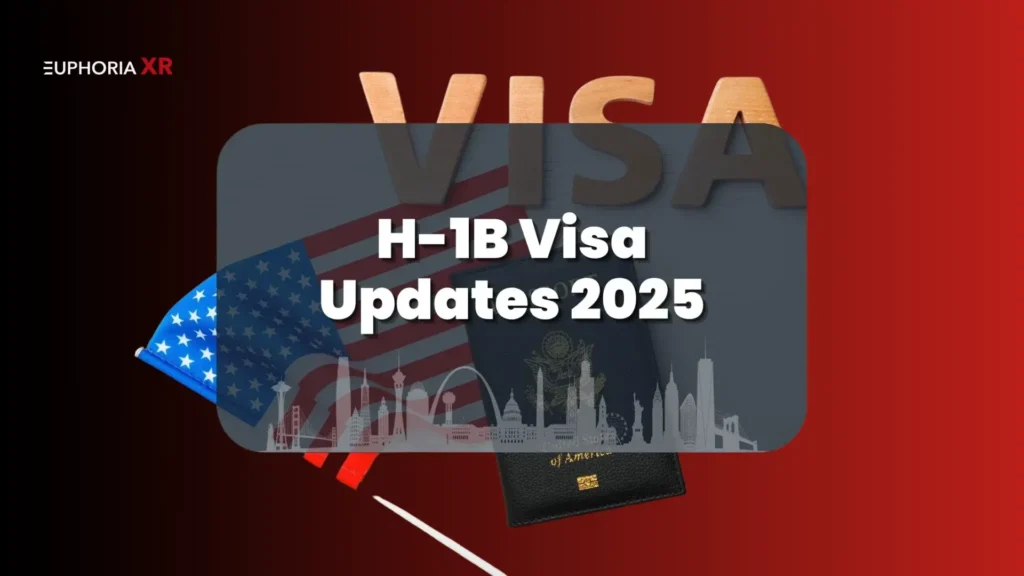Has it ever occurred to you that your Instagram feed seems to know you just as well as your best friend?
Why can TikTok predict your mood and offer videos that match before you realize what’s happening?
There’s no magic involved, and it’s nothing like coincidence.
Artificial intelligence in social media is working in the background to find out what you enjoy, how you browse, and when you are most active.
Here’s where it gets interesting…
The majority don’t use AI to engage with audiences, but the best brands are creating, organizing, improving, and automating their social media efforts using it.
If you haven’t used artificial intelligence in your social media yet, you’re already behind.
What Is Artificial Intelligence in Social Media?

Artificial intelligence in social media means smart technology that serves to assist platforms and companies in making more efficient and effective decisions. Instead of continuously randomizing posts, artificial intelligence studies user interaction regarding what they “like,” “share,” “comment,” or “scroll past” to personalize the experience and make it better.
Just imagine a super assistant working almost non-stop, whenever and wherever, creating posts, deciding when to publish them, and even determining their visibility to certain users.
AI in social media is the pulse behind smarter content and ad selection, as well as powering engagement with the likes of Instagram, Facebook, TikTok, and LinkedIn.
How Is Artificial Intelligence Used in Social Media?
AI is important for a wide range of uses, and here are the top roles:
Content creation and curation
Tools like Jasper, Copy.ai, or Lately make it easier for marketers to come up with captions, new ideas, and design content. Certain tools help by transforming one blog or video into a whole series of social media updates automatically.
Stat: AI-driven content tools, as revealed by HubSpot, let you publish on social media three times better and keep your content up to standard.
Personalized user experiences
Whenever you check out Instagram or TikTok, you might discover the content is exactly what you like. It means AI is reviewing how you use the site and recommending articles that you’ll like. It enhances user involvement with content and allows brands to be shown to those who should see them.
Social listening and sentiment analysis
Even without being tagged, people’s chats about a brand are noticed by AI. With Sprout Social or Brand 24, a business can observe keywords, hashtags, people’s comments, and how people feel in the moment.
Automation of posts and responses
Social media platforms help you set up posts for the right time, and many also reply to comments and messages from customers using chatbot services. As a result, businesses don’t need to sit at their computers or on their phone all the time.
Optimizing ads and marketing spend
It examines many ad variations such as headlines, images, and audiences and invests more money in ones that get the best results. Meta (Facebook/Instagram) and Google already take advantage of AI to allow brands to connect with more people using less budget.
Are you curious about how AI can boost your social media presence? Our professionals can help you.
Top 10 Applications of AI in Social Media Marketing
Content generation
Today’s AI tools help people write social media captions, make up hashtags, come up with ideas, and sometimes create whole posts or images along with them. Using artificial intelligence in Canva or Jasper, marketers can now create more content in less time, even if they feel writer’s block.
Why It Matters? It’s important because AI allows you to post more content and keep your feed predictable.
Social listening
Thanks to artificial intelligence, brands no longer need to be tagged to listen in on conversations on social media. Brandwatch and Sprout Social are among the tools you can use to see comments about your brand, your rivals, or buzzing trends online.
Bonus: Even more impressively, AI can sense the tone in what we say, whether something is good, bad, or simply neutral.
Predictive analytics for targeted campaigns
AI uses previous clicks, likes, and shares to guess the type of content your audience will respond to next. It allows marketers to put their efforts where they will have the biggest impact.
Example: With Cortex, predictive AI picks out the best post designs or formats to use.
Influencer identification and AI influencers
It’s tough to discover the right influencer, but AI can assist with this. It looks through a lot of creator profiles to align brands with people who have an appropriate audience, style, and audience involvement. A number of companies utilize artificial models and ambassadors created through AI.
Real World Example: An AI named Lil Miquela works with known brands, has worked with Calvin Klein, and has more than 2.6 million Instagram fans.
Real-time trend detection
Looking to get ahead of the latest trend?
Using AI, Trendspottr follows what’s trending on social media right away, helping you join in when it’s fresh.
Why it is important: Train your algorithm with data at the right time to stay one step ahead.
Ad budgeting, bidding, and split testing
AI provides more than ads; it aids in spending your money effectively. It tries out headlines, ad images, and audiences at the same time, then spends more funds on the top-performing ad versions.
Companies that use Meta and Google Ads currently trust in the power of AI to deliver top-performing ads.
Customer support and response automation
A chatbot, for example, ManyChat or Chatfuel, will help your customers anytime, whether your team is online or sleeping. I use them to handle regularly asked questions, make appointments, check order statuses, and so on.
Result: Thanks to this solution, customers are attended to faster, receive happier responses, and the workload for your support team goes down.
Image and video recognition
AI can analyze your images or videos to find the people, items, brands, and emotions inside. They use this to mark people on a post, sort content, or identify copyright.
TikTok and Instagram both provide you with more images or videos you’re apt to enjoy using this technology.
Smart post scheduling
Scheduling software like Buffer and Later can show you the best moments to share content, using the patterns of your audience.
Why it helps: Providing value when your audience is online means you’ll get more likes, comments, and shares without adding extra ad costs.
Performance analysis
After posting, AI tools give you a summary of what stuck with your followers and what didn’t, along with explanations. Using views, reach, saves, and CTR, they make the data into clear observations.
You don’t have to love numbers, because AI translates the data to let you act wisely.
Searching for innovative AI development? Explore customized solutions by visiting our AI Consultancy Services
AI Tools Powering Social Media Success
Everyone can try out artificial intelligence in social media with little expertise.
A number of simple tools exist that help with the hard work. Here’s a list of some of the best:
Text and visual content generation
Jasper, Copy.ai, and Canva AI allow you to create captions, make hashtags, and design posts all in a short time. This is the place to turn when you don’t have any ideas for your content, and it all feels quite empty.
In just a short time, Jasper can replicate the language of your brand.
AI-based ad management
AdCreative.ai and Madgicx let you use AI to build, test, and improve advertisements on popular social networks. They’ll show you the creative that’s bringing you the most and update the campaigns to reflect it.
Cut down on time spent on ads to put more effort into your strategy.
Logo detection and brand monitoring
Through image recognition AI, Brand24 and LogoGrab can spot your brand logo in photos uploaded by social media users, even if they have not tagged you.
You can track your brand’s visibility and find new partnerships with this information.
Influencer marketing platforms
With Upfluence, Influencity, and Heepsy, you can easily discover influencers who fit your audience and what you are looking for. They study how many people interact, the number of fake followers, the chosen niche, and other areas.
You won’t have to try to guess who will truly fit your brand anymore.
Scheduling and automation tools
With Buffer, Later, and SocialBee, you can use AI to help you decide the best time for posting and which hashtags to use, and these apps also reshare your most successful posts.
Workouts with Austin don’t take much time, and you can keep them up when your schedule is tight.
AI video repurposing
Lately.ai and Pictory allow you to break up lengthy videos (such as webinars or podcasts) and share them cut into social-size clips.
Being able to generate a lot of content quickly is how leading brands keep growing.
Key Benefits of Artificial Intelligence in Social Media
Why is all this important?
Let’s see what your brand can gain from using artificial intelligence in social media.
Increased efficiency and accuracy
With AI, there’s no more wondering about what or when to update. It automates both the creation of content and the review of analytical data, which saves time.
McKinsey’s research discovered that marketers using AI experience a 40% rise in productivity.
Better audience segmentation
By identifying groups among your audience according to their actions, interests, and demographics, AI allows you to send tailored content to each group.
As a result, you spend less time and get higher engagement with your data.
Enhanced customer experience
With AI, answers to users’ questions arrive more quickly and are more helpful than before. That results in people who enjoy and stick with your brand more.
Research from Salesforce shows that 69% of consumers pick brands that deliver both regular and prompt digital help.
Lower operational costs
It’s possible to manage social media well with just a small team. Machine learning makes it possible for your team to spend more time focusing on creative efforts.
Personalized content
AI detects what content your users engage with and provides more of it for them, for example, memes, videos, or how-to guides.
Real-time performance tracking
You don’t have to wait until the end of the month for your reports anymore. AI helps you see your results immediately during a campaign, so you can make improvements immediately.
Real-World Brand Examples Using Artificial Intelligence in Social Media
Heinz A.I Ketchup
Prompts like “ketchup in space” or “ketchup at a party” were used with DALL·E 2 to see what kinds of AI photos might result. The majority of results copied the look of Heinz bottles, helping to build the company’s image without showing the label.
Ryan Reynolds & Mint Mobile
Ryan Reynolds asked ChatGPT to produce a script for a Mint Mobile commercial. The ad was in keeping with his brand’s style and showed how AI helps with creating content in a snap.
Sephora & Ora
Customers at Sephora can get advice, suggestions, and assistance to schedule appointments from the AI chatbot called Ora. It lowers the work responsible for support and makes customers happier.
Ray-Ban & Meta
Users can now virtually try on a pair of Ray-Ban sunglasses using AI-powered AR filters on Instagram, thanks to Ray-Ban and Meta. With AI, frames are selected for each face, which boosts user involvement and makes more conversions possible.
Want to know how AI can simplify the things you are overcomplicating?
Building an AI-Powered Social Media Strategy
Define goals
The first step is to see which outcome you care about most: expanded reach, more engagement, leads, or automated customer service.
Choose tools
Use tools that match up with what you want to achieve. For creating your content, use Jasper; for scheduling it, choose Buffer, and use Brand24 to check your engagement.
Automate tasks
Let AI handle common tasks such as setting up post publishing, repeating content, dealing with chatbots, and improving your ads.
Analyze and optimize
Look at the results generated by AI to find out what is and isn’t working for you.
Ethical Considerations & Safe Use of AI in Social Media
Verify content
Review all artificial intelligence-generated text before using it, so you don’t unwittingly share false information.
Disclose AI usage
Tell people when the content came from AI or when they are using AI-based tools.
Monitor sentiment
Pay attention to people’s responses to AI-powered campaigns to make sure they meet the standards of the brand and its audience.
Set internal policies
Make sure there are clear rules for the use of AI on all your company’s social media profiles.
Challenges and Limitations of Artificial Intelligence in Social Media
Overreliance on automation
Where AI is overused, websites may show generic or emotionless text that doesn’t appeal to readers.
Loss of brand voice
Without fully understanding emotions, tone, or context, AI tools may cut the unique connection to the brand’s identity.
Misinformation risks
AI content may occasionally contain unchecked background info, so it needs to be checked for accuracy.
Data privacy
Working with user data via AI should be handled with fiduciary responsibility to satisfy rules and stick to user trust.
AI bias
The biases found in the dataset used to train AI models might cause results to be biased too.
The Future of Artificial Intelligence in Social Media
AI influencers and avatars
Brands choose AI influencers and avatars to generate content, reach customers, and organize campaigns, all without relying on human limitations.
Predictive and emotion-aware content
AI will soon be able to tell how users are feeling and which articles or videos will appeal to them right away.
AR/VR integration
AI-powered technology will make virtual and augmented reality on social apps better, so users can test products, go to virtual events, and enjoy engaging content.
Dynamic storytelling
Future content will be shaped by people’s actions online, with AI changing the stories, how things are presented, and messages to suit each user.
Do you require a unique solution for content creation or social media automation?
Conclusion: Optimizing Social Media with AI
Using artificial intelligence in social media is much more than a trend—it’s a set of tools to help businesses do their jobs better. If you’re looking to increase engagement, handle tasks automatically, or understand your audience more deeply, AI is here to offer help. Try the basics, check which tools work well, and add AI to strengthen your creativity, rather than changing it.
Frequently Asked Questions (FAQs)
What is AI in product development?
AI in product development means relying on systems like machine learning, NLP, and generative models to improve and speed up the process of creating and launching products.
How is generative AI used in product design?
With Generative AI, you can create samples of what the product might look like, dream up the UI, and visualize variations in user interactions, saving you time and leading to innovative ideas during the design process.
What are fairness measures in AI products?
Thanks to fairness measures, AI systems avoid repeating bias or discrimination. For this purpose, imbalance in training data needs to be addressed, outputs should be carefully checked, and algorithms beneficial for inclusion and ethics are required.
Can AI automate product management?
AI supports product managers by organizing user data, estimating the relevance of improvements, organizing project lists, and reporting in real-time, but people are needed to guide the company’s strategy.
Does EuphoriaXR provide AI solutions?
You can access AI development services from EuphoriaXR, such as chatbot creation, making accurate forecasts, and customizing your own AI models.















